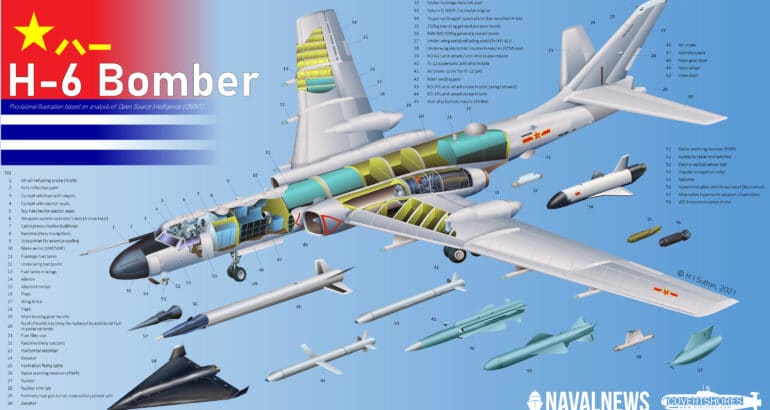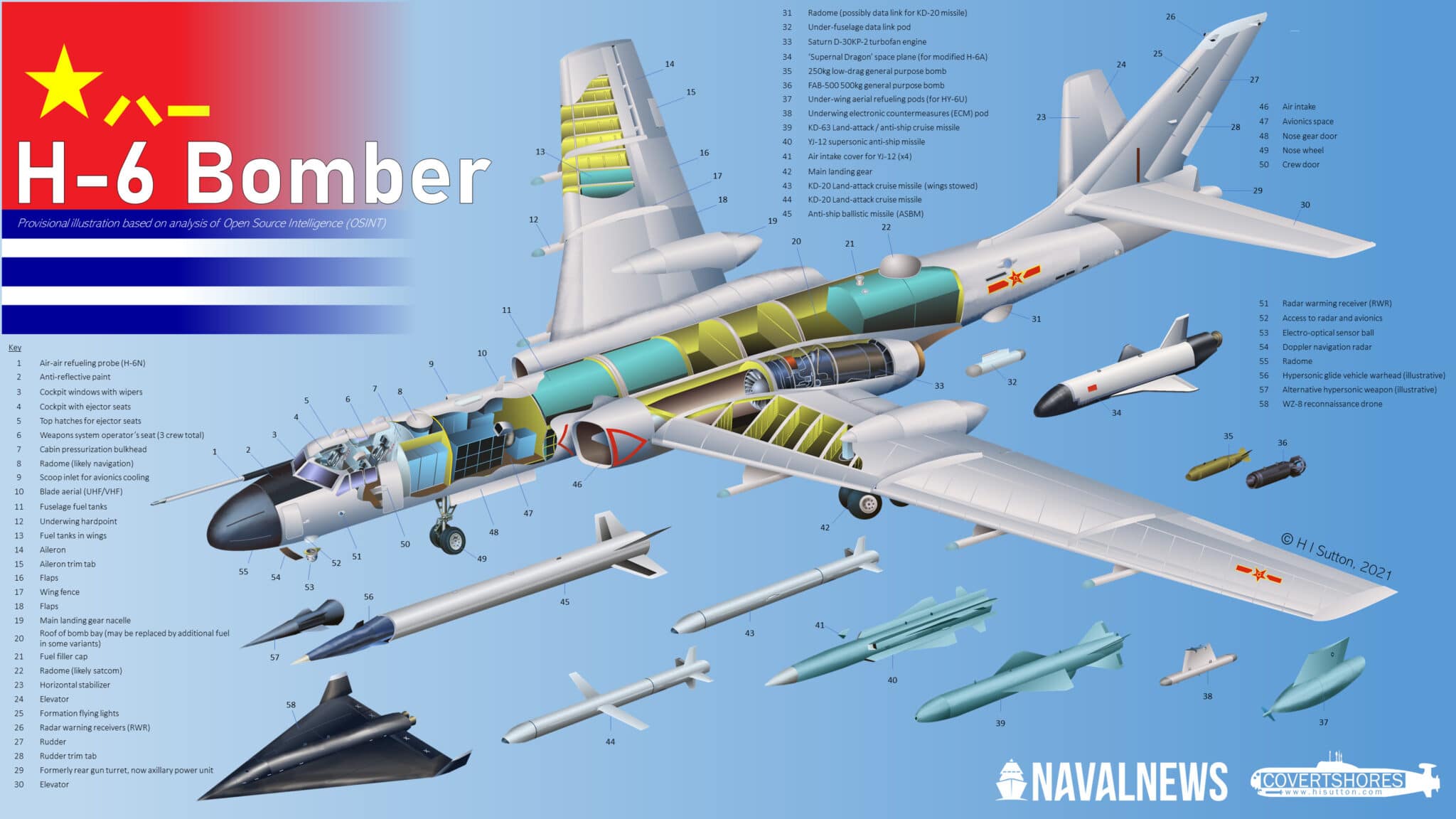
Click to Enlarge. The H-6 bomber is derived from the Soviet-era Tu-16 Badger bomber. It is a much more modern plane however. Of particular interest is the massive anti-ship ballistic missile, dubbed a 'Carrier Killer'.
The Unusual Carrier Killer Capability Of The Chinese Navy’s Strategic Bomber
Facing aircraft carriers from the U.S. Navy, Royal Navy, Indian Navy and Japanese, China is looking for a counter. The Chinese Navy (PLAN) has developed a unique 'Carrier Killer' weapon for its H-6 strategic bomber.
H I Sutton 23 Oct 2021China’s recent test of a hypersonic ‘Orbital Bombardment System’ has been characterized as a ‘Sputnik moment’. The world is only just waking up to Chinese advances in strategic weapons technologies. Among a raft of new weapons, which increasingly do not have direct equivalents in the West, are anti-ship ballistic missiles (ASBMs). One of these, an air-launched version, appears to include a hypersonic maneuvering missile.
The carrier of this missile is a plane which would have been familiar to those watching the Sputnik-1 satellite launch in 1957. But the modern Chinese Navy (PLAN) iteration, known as H-6, is far from outdated.
The Badger By Any Other Name…
China’s Xian H-6 is a direct evolution of the vintage Tupolev Tu-16 BADGER. In its original Soviet guise, the aircraft was seen as a medium bomber, but with a long range. It was not as large as the Tu-95 BEAR or M-4 BISON bombers, or as fast as the Tu-22M BACKFIRE. And in Russian service it was retired near 30 years ago. But in its Chinese form, it has been transformed into a potent bomber which is still formidable today. The Chinese models are of course much newer, largely dating from the last 20 years, and have much better engines.The current Chinese Navy version of the Tu-16 Badger has a number of basic upgrades besides avionics and weapons. The crew is reduced to three in a remodeled forward fuselage. And they are provided with ejection seats. The glazed nose is replaced by a large radome and the tail gun by an auxiliary power unit.
Carrier Killer Missile
The most formidable capability seen on the H-6 is believed to be an anti-ship ballistic missile. This massive weapon is the largest air-launched missile in the world. A single round has to be slung underneath the fuselage. And its primary prey is likely to be enemy aircraft carriers. For this reason, it has been widely dubbed a ‘carrier killer’. As far as strategic bombers go this capability is unique.It consists of a large rocket booster approximately 9 meters (33 feet) long. This is mated to a hypersonic missile which can maneuver to make it harder to counter and adjust for terminal guidance. The exact form of the terminal phase has not been confirmed. But China has shown a hypersonic glide body with its DF-17 land based missile.
The hypersonic payload is likely to include a maneuvering reentry vehicle which allows it to hit a moving target. And it means that it much harder to counter because it’s flight trajectory is unpredictable. Even without an explosive warhead the kinetic energy alone is likely to be enough to destroy a warship.
Anti-ship ballistic missiles are becoming a theme as more countries try to directly counter carrier battle groups and other large and well defended surface combatants. Other countries with them include Iran and Russia, and possibly India.
Other missiles carried include the workhorse KD-63. This is capable of both land attack and anti-ship attacks, but is an older weapon. It is typically carried in conjunction with newer missiles. For the land attack role these are the KD-20 air launched cruise missile. This is broadly equivalent to an air launched Tomahawk. For the anti-ship role it is the YJ-12. This is a large supersonic weapon loosely equivalent to the famous Russian Moskit (SS-N-22 Sunburn).
The H-6 is a versatile platform and can also carry out reconnaissance missions. The cutting edge of this is as a mothership for the WZ-8 drone. Like the ballistic missile this is likely to be slung under the central fuselage.

Outlook
With its array of advanced missiles, and the ASBM in particular, the H-6 gives the Chinese Navy extended reach. And when combined with the latest warships and submarines, underscores their focus on countering high value surface assets.This has to be regarded in context of US Navy, and now British or French, carrier battle groups. The ASBM program shows how highly the Chinese Navy regards the threat from aircraft carriers. At the same time, China is busy building up its own aircraft carrier capability.

The Unusual Carrier Killer Capability Of The Chinese Navy’s Strategic Bomber - Naval News
Facing aircraft carriers from the U.S. Navy, Royal Navy, Indian Navy and Japanese, China is looking for a counter. The Chinese Navy (PLAN) has developed a unique 'Carrier Killer' weapon for its H-6 strategic bomber.


